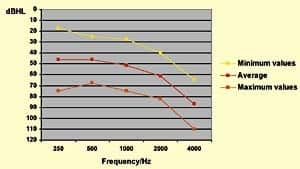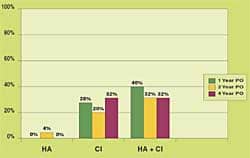Noise cancelers in hearing instruments work by reducing the gain based on specific criteria, such as the level of the input signal. Using digital technology, more complex algorithms for the action of a noise canceler are possible. One such strategy uses the estimated Speech-to-Noise Ratio (SpNR): when the SpNR deteriorates to a predetermined level, the noise canceller system is activated to reduce gain across a relatively broad frequency range. While these noise cancelers reduce broadband gain, alternative algorithms (e.g., a weighted per-band gain reduction) have been implemented in more recently introduced multi-band instruments.
In general, past clinical results with noise cancellation systems have shown only limited or inconclusive success in reducing noise or enhancing speech.1-5 A question of interest is whether the more complex noise cancelers implemented in some digital instruments can show an improvement over these past results.
Noise Cancellation:
A Difficult Task
Noise cancelers are implemented within the signal processing path of the hearing instrument, after the microphone has picked up both the desired speech signal and the undesired background noise. The noise canceler has the difficult task of reducing amplification of unwanted background noise while having minimal adverse effect on amplification of the speech signal.
It is generally accepted that noise cancelers can effectively improve listener comfort. However, compared to directional multi-microphones, noise cancelers have been shown in laboratory tests to be less effective in improving the SpNR or speech understanding in noise.6,7 This is understandable, because gain reduction for all or specific frequency regions—without discriminating between the signals originating from the front or back—reduces the level of speech signal components along with the noise components. In past comparisons of the speech-in-noise performance of people fit with instruments both with and without noise cancelers, the average intelligibility scores have not shown significant differences.1-2 Also, in some studies of subjects fit with digital hearing instruments, there were no statistically significant improvements in performance.3-5
Single versus Multi-Band
Noise Cancelers
In hearing instruments with few bands, the opportunity to improve the SpNR with noise cancelers is limited because gain is reduced over large frequency regions of the broadband speech signal—even when the noise has a narrow bandwidth. Conversely, a multi-band instrument has the potential to limit gain reduction to only those bands where noise reaches the criterion level (i.e., where the noise canceller becomes activated), potentially giving added benefits in situations where noise energy is concentrated in narrower bandwidths than the speech. A real-life example might be steady-state noises such as fans, inside a car, etc.
In general, the negative effects of a noise-canceler system on speech signals have been most successfully limited when the noisy situation is “not too bad” (i.e., when the SpNR is still positive). Only then can gain reduction reduce the noise to a level below, or almost below, audibility while the speech remains intelligible to the listener. This would not be the case in more difficult listening situations (i.e., 0 dB or negative SpNRs).
This brings us back to the question of whether some DSP instruments with greater signal processing abilities and more bands/channels can achieve greater effectiveness by using noise cancelling techniques that employ more complex criteria. A multi-channel noise cancellation system is employed in the Phonak Claro digital instrument which has 20-band signal processing and incorporates a noise canceler in each of its bands. The gain reduction is confined to those specific bands where the noise canceller becomes activated. Additionally, the amount of gain reduction is weighted using the Articulation Index (AI) and is also dependent on the actual estimated SpNR in each band. The dispensing professional has the further option to program the gain reduction of the noise canceler to be “light,” “moderate” or “strong,” depending on the chosen program (i.e., it is a three-program instrument).
Laboratory Study
A laboratory study of the 20-band noise canceler examined whether improvements in SpNR and in speech understanding could be demonstrated when the bandwidth of the noise is significantly narrower than that of speech (e.g., steady-state noises like air conditioning fans, car noise, etc.) and when the SpNR in these bands is poor (i.e., 0 dB or worse).
The evaluation used commercially available instruments and the manufacturer’s fitting software. To target the effect of the noise canceler alone, subjects’ performance on a speech test was evaluated using the basic program of the instrument only (Program 1, called QuietAdapt). The test was first performed with the noise canceler deactivated (“off” setting), then with the noise canceler programmed to two settings (“light” and “moderate”) in two narrowband noise conditions (250 Hz and 500 Hz). Authors’ Note: The “strong” noise canceler was not evaluated because it is not available for use in the basic hearing program. The “strong” noise canceller is an additional choice for Program 2 (called NoiseAdapt) and Program 3 (which has a number of dispenser-programmable choices) where greater gain reduction is applied than for “light” or “moderate.” The present study aimed to isolate the effect of the noise canceler only. Thus, Program 2 was not used because it includes other proprietary algorithm changes for noise conditions, as well as an adaptive twin-microphone noise reduction system.

Fig. 1. Average audiogram for left and right ears of 12 subjects.

Fig. 2. Average expected improvement in SpNR for a 20-band
noise canceler.
Subjects: The study used 12 adults with mild-to-moderate sensorineural hearing loss. Fig. 1 shows the average audiogram for left and right ears, and minimum and maximum hearing threshold levels for the subjects. All subjects except one were experienced hearing instrument users. The five women and seven men had an average age of 61 years (range: 36-76).
Procedure: Ten subjects were fit with behind-the-ear instruments (Claro 211 dAZ BTE); one subject received in-the-ear instruments (Claro 21 dAZ ITE) and one received an in-the-canal instrument (Claro 22 ITC). Six subjects were fit monaurally and six were fit binaurally. All fittings were programmed according to the recommendations of the manufacturer’s fitting software for the entered audiogram and were then fine-tuned, if warranted, according to the user’s comments. All earmolds were vented.
Test material was the Fournier bisyllabic word test.8,9 The two competing noise conditions were low frequency narrowband (NB) noises about one octave band wide. The noises were generated by a standard clinical audiometer (Interacoustics AC40). One noise had a center frequency of 250 Hz and the other a center frequency of 500 Hz. All tests were conducted in a sound booth.
Both the speech and the noise were presented from 0° azimuth, in front of the subject, at a distance of 1 meter. The intensity of the speech was fixed at 10 dB above the level at which the subject achieved 100% correct word identification in quiet in Program 1 of the instrument (this program is designed to be optimized for hearing in relatively quiet situations). The level of the noise was adjusted to achieve the required SpNR. All tests were conducted with the instruments in Program 1 and while connected to a PC via the programming cables.
For both noise conditions, the SpNR for 50% correct was determined with the instruments turned on, but with the noise canceler turned off. This was repeated with the “light” and the “moderate” noise canceler turned on. Percent-correct on the speech test was then determined with the instrument switched to Program 1 with the noise canceler set to “off”, “light” and “moderate” for both narrowband noise signals (250 and 500 Hz) at SpNRs of 0, -5, -10, -15, and -20 dB.
| Noise | NB 250Hz | NB 500Hz |
| Comparison off/light | +1.66dB Not significant |
+1.18dB Not significant |
| Comparison off/moderate | +3.9dB Significant (a=0.05) |
+3.29dB Significant (a=0.05) |
| Comparison light/moderate | +2.24dB Significant (a=0.05) |
+2.11dB Not significant |
| Table 1. Improvement in Speech-to-Noise Ratio (SpNR). | ||
| Noise | NB 250Hz | NB 500Hz |
| Comparison off/light | +10% Significant (a=0.05) |
+6.41% Not significant |
| Comparison off/moderate | +23.41% Significant (a=0.05) |
+18.08% Significant (a=0.05) |
| Comparison light/moderate | +15.58% Significant (a=0.05) |
+9.42% Not significant |
| Table 2. Improvement in intelligibility. | ||
Results
The averaged results for all subjects for improvement in SpNR for 50% correct are shown in Table 1. For both of the narrow-band noises, with the noise canceler set on “moderate”, the subjects could achieve 50% correct at an average 3-4 dB poorer SpNR than without the noise canceler. For the “light” noise canceler, the required SpNR for 50% correct was not significantly different to that of the "off" setting (1-2 dB difference) for either noise condition (Fig. 2). The difference in SpNR for 50% correct between the “light” and “moderate” settings was significant for the 250 Hz narrowband noise but not for the 500 Hz narrowband noise. The variability of the individual results shows that some subjects performed better than others (Figs. 3 & 4).

Fig. 3. SpNR for 50% correct for 250 Hz narrowband noise: individual subject results for three noise canceler conditions.

Fig. 4. SpNR for 50% correct for 500 Hz narrowband noise: individual subject results for three noise canceler conditions.
Comparisons of average improvement in percent-correct on the speech test for the different conditions are shown in Table 2. There was a 6-10% improvement in score for the “light” and about an 18-24% improvement in scores for the “moderate” noise canceler (Fig. 5).
Fig. 6 shows average percent-correct as a function of SpNR for each setting (“off”, “light” and “moderate”) for the 250 Hz noise signal. In negative SpNRs (between –5 dB SpNR and –20 dB SpNR), a 3-10% improvement in scores is shown for the noise canceler “light” and a 14-20% improvement in scores for the “moderate” condition (compared to “off”).
Fig. 7 shows average percent-correct as a function of SpNR for each condition for the 500 Hz noise signal. In negative SpNRs (between –5 dB SpNR and –20 dB SpNR), there was generally less average improvement in scores (5-9% compared to “off”), with a little more for the “moderate” than for the “light” setting.
Ceiling and floor effects are evident at the two extreme test conditions (0 dB SpNR and –25 dB SpNR) for both noises (Figs. 6 & 7).

Fig. 5. Average expected improvement in intelligibility (percent correct) for a 20-band noise canceler.

Fig. 6. Average intelligibility as a function of SpNR for three noise canceler conditions in 250 Hz narrowband noise.

Fig. 7. Average intelligibility as a function of SpNR for three noise canceler conditions in 500 Hz narrowband noise.
Discussion
Compared to many past studies of noise cancelers or noise canceling instruments1,2,7, this study showed a significant improvement in SpNR for 50% correct and a significant improvement in percent correct on a speech test. Since this study used only 12 subjects and the test situation and signals were confined to the laboratory, the results should be judged conservatively. However, this study suggests that using a multi-band (e.g., 20-band) noise canceler provides the potential for greater additional benefits, as well as listening comfort in noise (depending on the noise conditions), encouraging further investigation.
One could argue that narrowband noise is not a natural sound and would not reflect the efficiency of the instrument in real-life situations. However, in the absence of methods to evaluate the acoustics of real-life situations, this procedure is a possible way to demonstrate differences between different technologies. In that respect, the assessment of a “digital technology advantage” (due in this case to a digital multi-band noise canceler) using an easy, clinically practical procedure could become one of the needed tools to manage a price-per-performance policy11 for insurance or third-party payment purposes.
Results confirm the close relationship between SpNR and speech understanding in noise: the worse the SpNR, the poorer the speech test results. For this study, greater improvement was seen for the “moderate” than for the “light” noise-canceler setting. A question remains regarding whether the “strong” setting would result in even greater improvements.
Conclusion
When adults with mild-to-moderate hearing loss were tested using narrowband noises, the 20-band digital noise canceler was shown to provide improvements in SpNR for 50% correct and scores on speech tests across a range of negative SpNRs. This indicates that it is possible to design noise cancelers that are more effective in freeing the speech signal from the negative masking effects of steady-state background noises.
Further studies with a greater variety of subjects and test signals would be necessary to define further the benefits and limitations of this system.
This article was submitted to HR by Philippe Lurquin, MSc, scientific manager, and Caroline Delacressonniere, MSc, audiologist, of Lapperre Inc., and Anne May, MA, an audiologist at the Audiological Communication and Education Dept. of Phonak AG, Stäfa, Switzerland. Correspondence can be addressed to Anne May, Phonak AG, Laubistrütistrasse 28, CH-8712 Stäfa, Switzerland; email: [email protected].
References
1. Harnack Knebel S & Bentler R: Comparison of two digital hearing aids. Ear & Hear 1998; 19: 280-289.
2. Bille M, Jensen A-M, Kjaerbol E, Vesterager V, Sibelle P & Nielsen H: Clinical study of a digital vs analogue hearing aid. Scand Audiol 1999; 28 (2): 127-35.
3. Hosford-Dunn H: Your questions answered on digital hearing aids. Hear Jour 1997; 50:10-21.
4. May A, Brenner Larsen CB & Warland A: Multi-microphone instruments, DSP and hearing in noise. Hearing Review 1998; 5 (7).
5. Fabry D: Do we really need digital hearing aids? Hear Jour 1998; 51:30-33.
6. Elberling C, Ludvigsen C & Keidser G: The design and testing of a noise reduction algorithm based on spectral subtraction. Scand Audiol 1993; Suppl 38: 39-49.
7. Boymans M, Dreschler W, Schoneveld P & Verschuure H: Clinical evaluation of a full digital in-the-ear hearing instrument. Audiol 1999; 38:99-108.
8. Fournier JE: Evaluation de la perte auditive en pourcentage. Ann Otol 1960; 6: 450-468.
9. Portmann M & Portmann C: L’audiométrie vocale. In Masson’s (ed) Précis d’audiométrie clinique. Paris: Masson; 1978: 69-87.
10. Killion M: The SIN report: Circuits haven’t solved the hearing-in-noise problem. Hear Jour 1997; 50:28-34.
11. Kochkin S. MarkeTrak V: ‘Why my hearing aids are in the drawer’: The consumer perspective. Hear Jour 2000; 53 :34-42.





